 |
 |
Singlehander Barnes Rescued, Boat ScuttledJanuary 5 - Punta Arenas, Chile 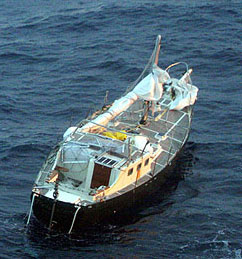 A Chilean Navy P3 (C130) aircraft out of Punta Arenas located the disabled Privateer yesterday afternoon. Photo Chilean Navy SoCal singlehander Ken Barnes was safely rescued at approximately 0300 this morning by the fishing trawler Polar Pesca several hundred miles west of Cape Horn, after drifting for three days aboard his dismasted 50-ft (LOA) staysail ketch Privateer. Barnes had been attempting a nonstop solo circumnavigation. Circumstances at the time of the dismasting have yet to be clarified, but both masts were lost. Additionally, the steel Gulfstream 44, built in Malta to a Maurice Griffiths design, suffered damage to her rudder, engine and a hatch. Barnes reported earlier that he planned to scuttle her upon being rescued, which has now presumably been done, thus ending his lifelong dream. 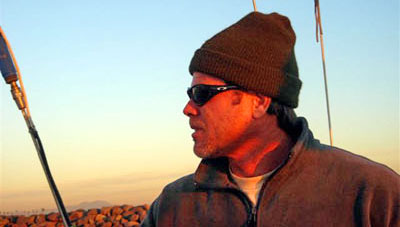 Singlehander Ken Barnes' dreams were dashed by the Southern Ocean. Photo www.kensolo.com With the loss of his masthead antennas, Barnes' satphone played a key role in the rescue. In addition to setting off his EPIRB, Barnes used the satphone to alert friends back home in Newport Beach and later to communicate with rescue personnel. As with all such Southern Ocean rescues, locating and later rescuing Barnes involved a substantial cooperative effort involving the Chilean Navy, U.S. Coast Guard, U.S. Embassy, the Polar Pesca and at least one other commercial vessel. Meanwhile, singlehander Donna Lange is simultaneously approaching Cape Horn, now approximately 150 miles from the site of Barnes rescue. She also assisted with info during the rescue process. Lange hopes to complete her rounding before the next punishing storm system arrives in a few days. She will then be on her final leg to Rhode Island to complete her solo run. (See www.kensolo.com and www.donnalange.com for further info on both sailors.) - latitude/aet |
New Year's Day Sailing in California, Pt. IJanuary 5 - San Diego 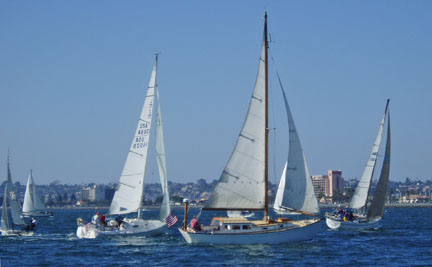 A variety of sloops racing on San Diego Bay "It's a tradition!" Sailing on New Year's Day in San Diego that is. Whether they were racing or cruising, on dinghies, multihulls, the latest sloop or the saltiest schooner, sailors young and old enjoyed the sunshine and nice, steady breeze. More than 100 boats competed in the New Year's Day Race. For complete results, see San Diego YC's racing pages at www.sdyc.org/raceinfo/index.htm. - latitude / cw  The Holder 20 Problem Child rounds the leeward mark. 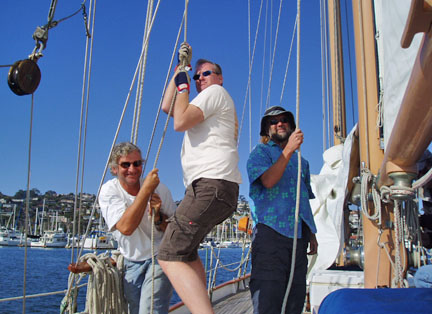 Lindsay, Tom and Gary set the sails for a cruise on the 61-ft 1930 Alden schooner Dauntless.  Three generations behind the wheel of Dauntless: Grandpa Paul Plotts, seven-year-old grandson Paul driving, and dad Tom 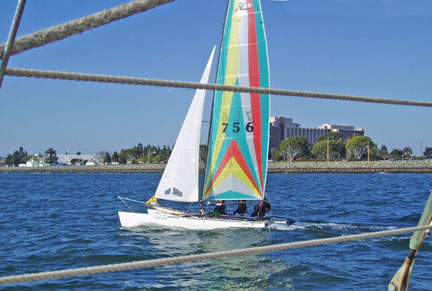 Three on the wire on the Hobie 20 Red Eyed Tree Frog, one of many beach cats in the regatta 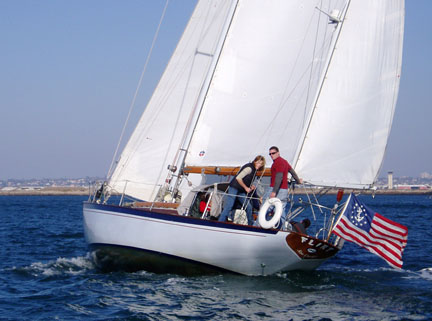 The classic ketch Flirt heading back into the bay from a jaunt out past Pt. Loma. Photos Latitude/Chris |
New Year's Day Sailing in California, Pt. IIJanuary 5 - Alameda Meanwhile, back in NorCal, Lucie Mewes reported the New Year's Day circumnavigation of Alameda: "Four yachts and about 30 people clustered at sunrise at Island YC for blood orange mimosas (from my tree!) and pastries before heading on the high tide to Aeolian YC for chili and fizzes. The three bridge tenders were waiting, and smiled at our 'Happy New Year' shouts. 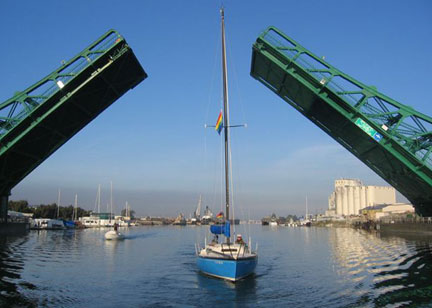 Bart Goodall's SC 27 Vitesse motors through Park Street bridge. Photo Elizabeth Sleeth "A huge flotilla departed through the raised Bay Farm Island Bridge along San Leandro Channel, and snugged into the narrow channel in the ebbing tide. Lucky for us the PVC tube 'marks' are visible so none in our fleet were stuck in the mud. "We made it through the dense fog on to Ballena Bay YC. Some reports of cruisers missing the breakwater in the fog are totally true and one boat mistook a tree for a daymarker - temporarily. In fact, we had a whole group of 'RTI virgins' getting tables together at the new Pier 29 (the old Whale's Tale) because the buildings all looked alike in the fog! We led them to the correct yacht club when we found them. "Those of us who braved the 35-knot gusts under the High Street Bridge last year were grateful for this year's beautiful weather." - lucie mewes |
Racing News from Down UnderJanuary 5 - The Southern Hemisphere Fortunately, our 'racing department's trip to the Southern Hemisphere for the holidays coincided with several sailing events Down Under. Unfortunately, we're a few time zones too far east, in New Zealand. But it's been great to watch sailing on the evening news, right alongside the other Antipodean favorites, namely cricket and rugby. Catching up with the 'local' events, Kiwi
Graham Dalton and Unai Barsurko of Spain crossed the Velux 5
Oceans first leg finish line in Fremantle on January 1 and 2,
respectively. Separated by 16 hours, their finishes were among
the most If there is a saving grace in this for the so-called "B fleet" competitors - both are apparently pleased with the results. Sailing the only Open 50 in the now five-boat race, the 54-year old Dalton says he entered for the personal challenge and is committed to finishing regardless of where he places. Although his boat suffered considerable damage to the mainsail and the rudders, Dalton believes he will be ready for the second leg, which starts January 14. We understand that his boatbuilder, Davie Norris, of Christchurch, NZ, was in Oz awaiting his arrival. Meanwhile, Basurko, 33, is competing in his first solo circumnavigation in his new Open 60 and continues to learn about his boat and the harsh realities of ocean racing. Despite numerous problems to Pakea and unfavorable weather patterns, Basurko sees his fifth place finish as an important achievement. On the other side of Australia, the books have also closed on the 2006 Rolex Sydney-Hobart race. David Kent's 32-ft boat, Gillawa, set a new race record for taking the wooden spoon (the last boat in) for the third straight year. This year her crew finished in time to catch the New Year's fireworks display in Hobart. The majority of the top race's top silverware was picked up by Bob Oatley's Wild Oats XI and Simon Kurts' Love & War. 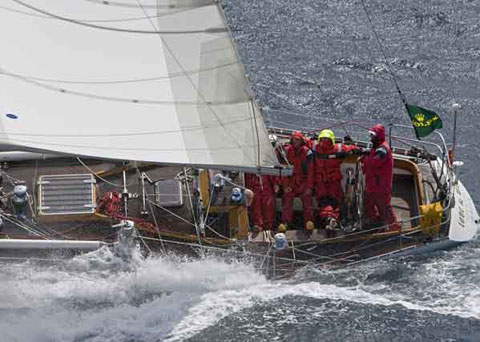 Corrected time winner Love & War sailing off the Australian coast. Photo Daniel Forster / Rolex In a race that saw two dismastings, one sinking, six other retirements, and several emergency crew evacuations, the pundits have had a field day criticizing the race's existence. So it's worth noting a comment by Geoff Lavis, commodore of the race organizer, Cruising Yacht Club of Australia: "This race was one of the better races that we've had. This race was very, very good for sailing and yacht racing in general. It was a fairly hard race, it had retirements, it had a boat sinking, it had injuries, so there was drama. Overall it was a very, very tactical race for the boats competing and it was a great result for the Corinthian style of boat to take first, second and third overall under IRC handicap. As Commodore of the CYCA, I am very proud to be the representative of the club at this point in time." - latitude / ss |
Time to Clean Out the EPIRB ClosetJanuary 5 - Planet Earth If you still have an old-school 121.5 to 243 MHz EPIRB, it's time to upgrade to a digital 406 MHz model. As of January 1, all Class A, B and S 121.5/243 MHz units are prohibited from use in commercial and recreational boats (the regulation doesn't affect the 121.5/243 man-overboard units which don't go through the Cospas-Sarsat Satellite System). These models had a bad habit of going off accidentally, resulting in wasted SAR operations - only 1 in 50 ended up being a real emergency - and have been replaced with the much more reliable 406 MHz EPIRBs. Satellites will stop processing signals from the old models on February 1, 2009. As a reminder, in the U.S., all EPIRBs must be registered at www.beaconregistration.noaa.gov - or call (888) 212-SAVE. - latitude / ld |